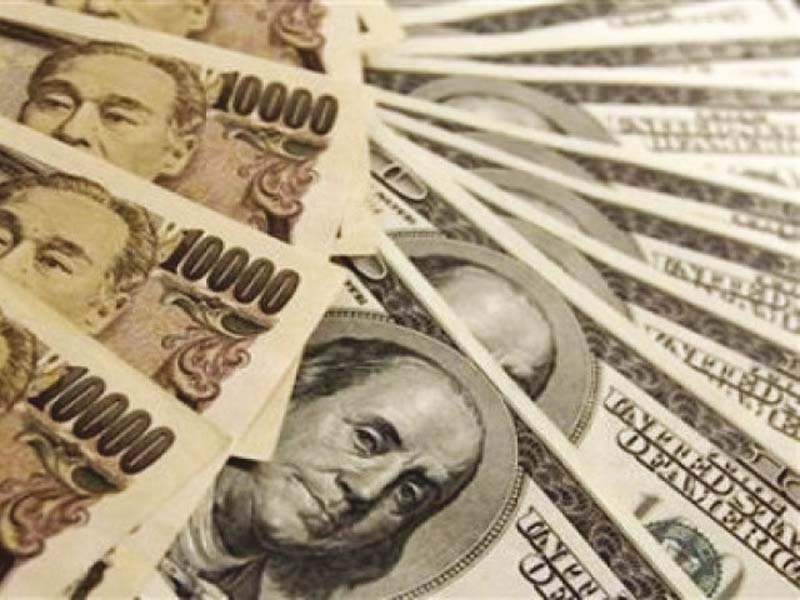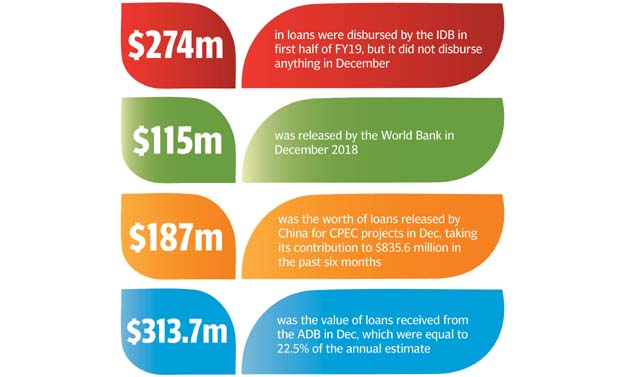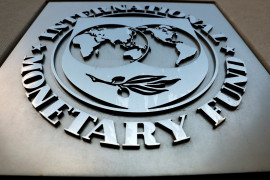
Pakistan received $2.2 billion in loans from bilateral and multilateral lenders during the July-December period of fiscal year 2018-19, according to the Economic Affairs Division (EAD). The disbursements were equal to only 23% of the original annual estimate of the finance ministry.
Owing to the low disbursements, the central bank’s official gross foreign currency reserves have remained under pressure.
The $3-billion loans that Pakistan got from Saudi Arabia and $1 billion from the UAE are not part of these releases.
Despite growing need, foreign loans plunge 37% to $930m
The financial assistance from these countries has been shown on the central bank’s books. Despite the arrival of $4 billion, the official gross foreign currency reserves held by the State Bank of Pakistan (SBP) stood at $8.6 billion.
The disbursements in July-December 2018 from international creditors were down by $3.5 billion compared with the loans received in the same period of previous fiscal year. From July through December 2017, Pakistan had received $5.7 billion in loans on the back of $2.5-billion sovereign bonds.

Finance Minister Asad Umar took a briefing from the EAD last week on the status of foreign-funded projects, according to the ministry’s officials. They said the finance minister was not happy with the slow releases, although the EAD stated that the disbursements picked up in December.
The finance minister directed the authorities to develop a mechanism for fast-track approval and implementation of foreign-funded projects. Planning Minister Khusro Bakhtyar on Monday chaired a meeting to develop such a mechanism, which was also attended by the adviser to prime minister on institutional reforms. In December alone, Pakistan received half a billion dollars in foreign loans, primarily because of inflows from China and the Asian Development Bank (ADB), showed official statistics of the EAD.
Last month, Pakistan received another short-term commercial loan facility of $25 million from a consortium led by Credit Suisse AG, taking its total contribution in first half of the current fiscal year to $295 million.
Foreign loans are not sufficient to meet Pakistan’s growing financing needs, which have now been revised downwards to $22 billion on hopes that the government will be able to curtail the current account deficit to $13 billion. However, the current account deficit - the gap between external receipts and payments -contracted only 4.4% to $8 billion in the first half.
A key reason for the low disbursements is the delay in finalising a bailout programme with the International Monetary Fund (IMF), which has affected disbursements from the World Bank and the ADB. These lenders are not giving policy loans to Pakistan due to the absence of a Letter of Comfort from the IMF.
Jul-Nov 2018: Pakistan receives only $1.7b in foreign loans
Owing to the lenders’ refusal to approve new policy loans, the share of project lending increased to 60% in the total inflows in the first half. The government has also dropped the plan of floating $3 billion worth of Eurobond, replacing it with commercial loans. However, these commercial loans have not yet been materialised.
Beijing in December released another $187 million, largely for the China-Pakistan Economic Corridor (CPEC) projects, taking its contribution to $835.6 million in the past six months. The loans have been disbursed for the Sukkur-Multan motorway ($439 million), Havelian-Thakot project of CPEC ($131 million) and Lahore Orange Line project.
The Chinese loans were equal to 39% of the total disbursements Pakistan received from July through December, according to the EAD. The disbursements from China were higher than the total loans given by all multilateral lenders.
The country received $313.7 million from the ADB, which was equal to 22.5% of the annual estimate. The ADB disbursed loans for the Peshawar transit bus project, access to clean energy and integrated transit trade at international borders.
The World Bank disbursed only $115 million, or 14% of the annual estimate.
The Islamic Development Bank did not disburse any amount in December, which kept its total loans for Pakistan at $274 million in the first half.
Published in The Express Tribune, January 29th, 2019.
Like Business on Facebook, follow @TribuneBiz on Twitter to stay informed and join in the conversation.



































1713853507-0/MalalaHilary-(2)1713853507-0-270x192.webp)







COMMENTS
Comments are moderated and generally will be posted if they are on-topic and not abusive.
For more information, please see our Comments FAQ